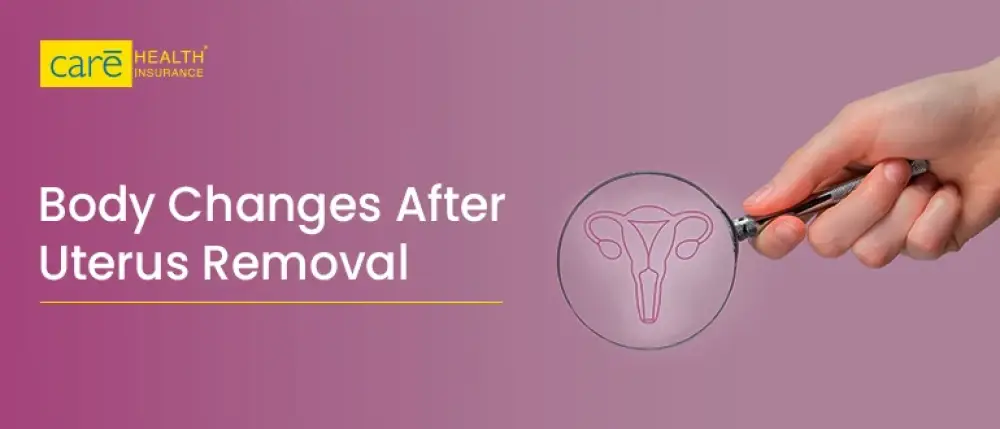Subscribe to get weekly insights
Always stay up to date with our newest articles sent direct to your inbox
Published on 6 Nov, 2025
73 Views
4 min Read

Written by Leena Khowal
Reviewed by Ritika Malik
favorite0Like
favoriteBe the First to Like
Uterus removal, or Hysterectomy, is a life-changing procedure that brings both physical and emotional adjustments. Many women undergo it to treat conditions like fibroids, endometriosis, or prolonged bleeding. Interestingly, the numbers vary across countries in the UK; one in five women has a hysterectomy by age 60, with ovaries removed in about 20% of cases. In Germany, around 1.5 lakh surgeries are performed yearly, primarily among women aged 40–49, while in Denmark, rates have dropped by 38% since the 1980s as surgical techniques evolved.
Understanding the changes after uterus removal - from hormonal shifts to physical recovery helps you adapt more effectively and embrace this new phase with confidence.
A Uterus Removal is a surgical procedure that removes the uterus and cervix, while a supracervical Uterus Removal preserves the cervix. These surgeries may also involve the removal of the ovaries (oophorectomy) or fallopian tubes (salpingectomy). Performed mainly by gynaecologists, hysterectomies serve as a form of sterilisation and are generally only recommended when other treatments have failed. It is the second most common gynaecological surgery in the U.S., often done for conditions like endometriosis and uterine fibroids, and its usage for non-cancerous reasons is expected to decline with new treatment options.
There are several types of Uterus Removal surgeries, including:
Healthcare providers frequently recommend exploring alternative treatments before suggesting a Uterus Removal, depending on the underlying reason for the procedure. In some cases, these alternative options may not provide relief, making surgery the necessary course of action.
Surgeons perform hysterectomies to treat:
Many women choose uterus removal as a preventive step against certain cancers. However, it’s essential to note that this procedure can be expensive, often requiring hospital stays, medications, and follow-up care, which may result in unexpected medical expenses. That’s where a good health insurance plan becomes essential; it helps cover surgery costs, consultations, and other treatment-related expenses, easing your financial burden during recovery.
Uterus removal can bring several physical and hormonal changes. Sometimes, ovaries are removed unintentionally, leading to early menopause. Even if preserved, ovaries may stop working correctly in many women, and some may need hormone replacement therapy. Benign ovarian cysts can also develop after surgery.
Many women notice improved sexual health and reduced pelvic pain after surgery for benign conditions. However, some may experience worsening sexual issues, especially if the procedure is extensive due to cancer or chronic pain.
Removal of ovaries causes sudden estrogen loss, known as surgical menopause, which increases risks of heart disease, low bone density, and fractures. Testosterone levels also drop, potentially affecting sexual desire and bone strength.
Urinary incontinence and vaginal prolapse can appear 10–20 years after surgery. Risks increase with vaginal births, difficult deliveries, or the type of surgery.
Scar tissue (adhesions) can form after surgery, sometimes leading to bowel obstruction, especially in non-laparoscopic procedures.
Weight may fluctuate due to hormonal changes, shifts in appetite, or inactivity related to recovery. Fatigue is common due to healing, nutrient deficiencies, or anaemia. Stress during recovery can also affect appetite and weight.
If you experience any of the problems described above, there are several steps you can take to address them. These can be divided into short-term and long-term lifestyle changes.
The first few weeks after uterus removal are crucial for healing. Your body needs rest, balanced nutrition, and gentle care to recover safely and effectively.
Once initial healing is complete, long-term habits help your body adapt and stay healthy. Maintaining a consistent exercise regimen, a balanced diet, and effective stress management is key.
>>Read More: Uterine Fibroids: Here is What Women Should Know About its Causes and Treatment
Undergoing a Uterus Removal can be a life-changing experience, but with the correct knowledge and steps, you can navigate this journey with confidence. Remember, every woman's experience is unique, so it's essential to prioritise your physical and emotional well-being throughout the process. By understanding the reasons for Uterine Removal, the procedure involved, and, most importantly, the post-surgery changes that are noticed, one will be better equipped to take control of their health and make informed decisions. Stay empowered, stay informed, and remember that you're not alone.
Disclaimer: All plan features, benefits, coverage, and claims underwriting are subject to policy terms and conditions. Kindly refer to the brochure, sales prospectus, and policy documents carefully.
favoriteBe the First to Like
Thyroid : मामूली नहीं हैं महिलाओं में थायराइड होना, जानें इसके लक्षण और घरेलू उपचार Vipul Tiwary in Diseases
शुगर कंट्रोल कैसे करे? जानें, डायबिटीज में क्या खाना चाहिए Vipul Tiwary in Health & Wellness
हाई ब्लड प्रेशर को तुरंत कंट्रोल कैसे करें? देखें इसके उपाय Vipul Tiwary in Diseases
पैरों में दर्द किस कमी से होता है? जानें, इसके घरेलू इलाज Vipul Tiwary in Health Insurance Articles
Fecal Transplant for Weight Loss: Can Gut Bacteria Help You Slim Down? Pratham Gupta in Surgery
Anaesthesia Allergy: How to Stay Safe During Surgery Sambriddhi Sharma in Diseases
Liver Transplant: Cost, Insurance & Success Rate Sambriddhi Sharma in Surgery
Is Sciatica Surgery the Only Option for Back Pain? Things You Need to Know Sejal Singhania in Surgery
Yes, some women may experience emotional changes, such as mood swings, anxiety, or depression, due to hormonal fluctuations.
Typically, 4-6 weeks of rest and recovery are recommended.
Yes, but it's essential to wait for your doctor's clearance and follow specific guidelines to avoid complications.
Possibly, as the surgery can trigger early menopause in some women.
Typically, follow-up appointments are scheduled 2-4 weeks after surgery, and then annually or as recommended by your doctor.
Always stay up to date with our newest articles sent direct to your inbox
Loading...